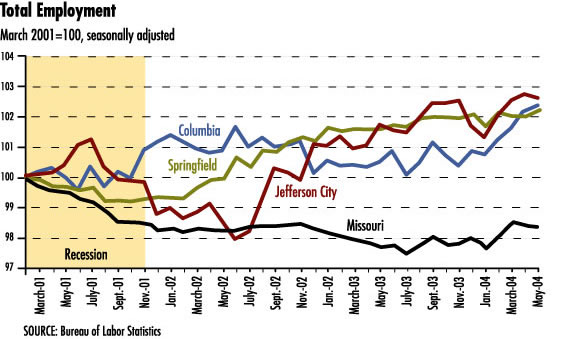District Overview: Employment Trends Vary in Three of Missouri's Metro Areas
The three metropolitan areas located in the St. Louis Zone of the Eighth Federal Reserve District-other than St. Louis-are Springfield, Columbia and Jefferson City. All three cities have witnessed changes in their labor markets over the past four years. However, the experience of each has differed somewhat from that of the other two.
During the national recession, which lasted from March 2001 to November 2001, all three metropolitan areas saw decreases in their total employment levels as measured by the Bureau of Labor Statistics' Quarterly Census of Employment and Wages, a survey of more than 8 million establishments nationwide. As the figure shows, Springfield's total employment decreased gradually during this period, thereby most closely resembling the experience of the state of Missouri as a whole. Springfield has recovered more robustly than the state, however, as it regained pre-recession employment levels by mid-2002. Over the next two years, employment grew steadily, rising by nearly 4,000 jobs as of June 2004.
Columbia, in contrast, maintained comparatively stable employment during the recession. At times, Columbia's employment dropped below its March 2001 level, but these losses never amounted to more than 0.5 percent of total employment. Throughout 2002 and 2003, employment remained slightly higher than the March 2001 level and then entered a period of stronger growth during the first half of 2004, when nearly 1,200 jobs were added.

Still different was Jefferson City, where employment rose briefly during the first half of the 2001 recession, then declined over the remainder of that year. Jefferson City continued to lose employment through the first half of 2002, shedding roughly 600 jobs between January and July. In the two years following the summer of 2002, however, employment gradually trended up. By June 2004, Jefferson City's total employment stood approximately 2.5 percent (or about 1,900 jobs) higher than its March 2001 level.
In Springfield, underlying the decline in employment during the national recession were job losses primarily in manufacturing and professional and business services, both of which decreased at annual rates in excess of 5 percent during 2001. Job losses in trade, transportation and utilities also contributed to the overall contraction. Springfield's recovery was driven by job gains across an array of sectors, especially financial and education/health services. Employment also increased in trade, transportation and utilities. Beginning in 2003, employment also began to rise in professional and business services.
Of these three metropolitan areas, Columbia exhibited the steadiest labor market between 2001 and 2004. As the figure shows, employment neither decreased nor expanded substantially over this time period. This pattern stems from job losses in the same two sectors that drove Springfield's job losses in 2001-manufacturing, and professional and business services-combined with employment gains in a wide range of industries, including construction, education and health services, financial services, and the category of trade, transportation and utilities. On net, job gains in these sectors, as well as a relatively stable manufacturing sector after 2003, allowed Columbia to gain about 1,800 jobs over the entire period.
In Jefferson City, total employment began to decline during the middle of 2001 primarily because of job losses in manufacturing. Additional losses in finance as well as in trade, transportation and utilities contributed to an overall decline of roughly 1,500 jobs between March 2001 and July 2002. For the next two years, however, Jefferson City's job market steadily recovered as professional and business services, construction, educational and health services, and financial services all added jobs. Manufacturing, which stabilized early in 2003, further contributed to Jefferson City's growth.
Recent data from the Bureau of Labor Statistics' payroll survey, which samples a smaller number of establishments than does the Bureau of Labor Statistics' Quarterly Census of Employment and Wages but is available through the end of 2004, suggest that these recoveries continue to strengthen. In the second half of 2004, Missouri's total employment grew by roughly 10,000 jobs due to positive growth in nearly all major sectors, including education and health services, professional and business services, construction and the category of trade, transportation and utilities. Manufacturing also continued to grow after several years of decline, adding approximately 1,000 jobs between June and December. On the whole, these figures suggest that Missouri's labor markets ended 2004 on an upswing. While still below the March 2001 level, the state's total employment at the end of 2004 stood nearly 30,000 jobs higher than its July 2003 level.
Views expressed in Regional Economist are not necessarily those of the St. Louis Fed or Federal Reserve System.
For the latest insights from our economists and other St. Louis Fed experts, visit On the Economy and subscribe.
Email Us

